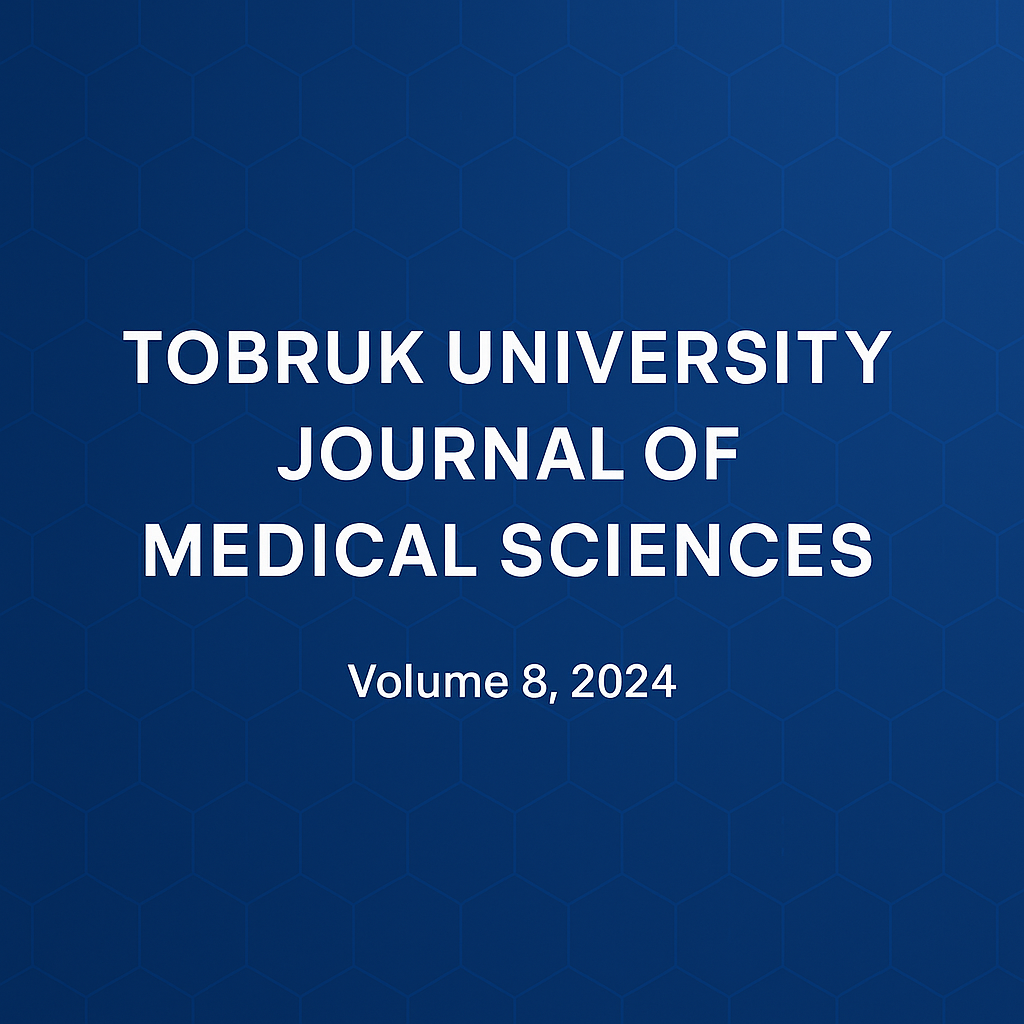The Efficiency of Flexible Insulin using Carbohydrates Counting Program on Glycated Hemoglobin Test (HBA1C) Level in Diabetic Pediatric Patients in Tripoli
DOI:
https://doi.org/10.64516/j0b2hw21Abstract
Background: The carbohydrate (CHO) counting program is used to adjust pre-meal insulin in intensive insulin regimens by using mathematical operations to convert grams of carbohydrates into equal units of insulin. However, diabetes mellitus children’s patients in Libya are still treated with a fixed amount of insulin doses. CCP and determining the insulin dose after meals have proved its efficiency globally.
Objective: This study aimed to evaluate the effectiveness of flexible insulin using a carbohydrate counting program on the HbA1c level in pediatrics in Libyan hospitals.
Methods: Forty-five children aged between 2 and 18 from Aljala Children Hospital -Tripoli were observed for three months for their HbA1c, which is the factor that is followed by doctors to determine the effectiveness of the insulin daily doses using CCP of their cases. This study was conducted to compare the level of HbA1c before the beginning of the program of carbohydrate counting and three months later. Affective factors may cause significant differences in the efficiency of CCP, such as place of residency, BMI, gender, age, and other associated diseases. The collected data was statistically analyzed.
Results: The results indicate a notable reduction in HbA1c levels in children who adhered to the carbohydrate counting program (CCP). Additionally, attention was given to side effect factors to understand their impact on HbA1c levels and how they are interrelated. Factors like weight and insulin doses were found to have a significant influence, as the response to the CCP program varied among cases based on these factors.
References
1- Adams, I. (2011). Carbohydrate Counting.
2- Ashabani, A., Abushofa, U., Abusrewill, S., Abdelazez, M., Tučková, L., & Tlaskalová‐Hogenová, H. (2003). The prevalence of coeliac disease in Libyan children with type 1 diabetes mellitus. Diabetes/metabolism research and reviews, 19(1), 69-75.
3- Bell, K. J., Barclay, A. W., Petocz, P., Colagiuri, S., & Brand-Miller, J. C. (2014). Efficacy of carbohydrate counting in type 1 diabetes: a systematic review and meta-analysis. The Lancet Diabetes & Endocrinology, 2(2), 133-140.
4- Chiesa, G., Piscopo, M. A., Rigamonti, A., Azzinari, A., Bettini, S., Bonfanti, R., ... & Chiumello, G. (2005). Insulin therapy and carbohydrate counting. Acta Biomed, 76(Suppl 3), 44-48.
5- Dias, V. M., Pandini, J. A., Nunes, R. R., Sperandei, S. L., Portella, E. S., Cobas, R. A., & Gomes, M. D. B. (2010). Effect of carbohydrate counting on glycemic control in patients with type 1 diabetes. Diabetology & metabolic syndrome, 2(1), 1-7.
6- Enander, R., Gundevall, C., Strömgren, A., Chaplin, J., & Hanas, R. (2012). Carbohydrate counting with a bolus calculator improves post-prandial blood glucose levels in children and adolescents with type 1 diabetes using insulin pumps. Pediatric diabetes, 13(7), 545–551
7- Fu, S., Li, L., Deng, S., Zan, L., & Liu, Z. (2016). Effectiveness of advanced carbohydrate counting in type 1 diabetes mellitus: a systematic review and meta-analysis. Scientific reports, 6(1), 1-8.
8- Gökşen, D., Altınok, Y. A., Özen, S., Demir, G., & Darcan, Ş. (2014). Effects of carbohydrate counting method on metabolic control in children with type 1 diabetes mellitus. Journal of clinical research in pediatric endocrinology, 6(2), 74.
9- Kawamura, T. (2007). The importance of carbohydrate counting in the treatment of children with diabetes. Pediatric diabetes, 8, 57-62.
10- Kadiki, O. A., Reddy, M. R. S., & Marzouk, A. A. (1996). Incidence of insulin-dependent diabetes (IDDM) and non-insulin-dependent diabetes (NIDDM)(0–34 years at onset) in Benghazi, Libya. Diabetes research and clinical practice, 32(3), 165-173.
11- Kostopoulou, E., Livada, I., Partsalaki, I., Lamari, F., Skiadopoulos, S., Rojas Gil, A. P., & Spiliotis, B. E. (2020). The role of carbohydrate counting in glycemic control and oxidative stress in patients with type 1 diabetes mellitus (T1DM). Hormones, 19, 433-438
12- Lowe, J., Linjawi, S., Mensch, M., James, K., & Attia, J. (2008). Flexible eating and flexible insulin dosing in patients with diabetes: results of an intensive self-management course. Diabetes research and clinical practice, 80(3), 439-443.
13- Mehta, S. N., Quinn, N., Volkening, L. K., & Laffel, L. M. (2009). Impact of carbohydrate counting on glycemic control in children with type 1 diabetes. Diabetes Care, 32(6), 1014-1016.
14- Mohammed, R. R. (2016). Antidiabetic effects of laurus nobilis l. leaf extract in streptozotocin-induced diabetic rats: Histopathological, immunohistochemical and biochemical investigations (Master's thesis, Sağlık Bilimleri Enstitüsü).
15- Peer, N., Kengne, A. P., Motala, A. A., & Mbanya, J. C. (2014). Diabetes in the Africa Region: an update. Diabetes research and clinical practice, 103(2), 197-205.
16- Robart, E., Giovannini-Chami, L., Savoldelli, C., Baechler-Sadoul, E., Gastaud, F., Tran, A., ... & Hoflack, M. (2019). Variation of carbohydrate intake in diabetic children on carbohydrate counting. Diabetes Research and Clinical Practice, 150, 227-235.
17- Rowe, C., Lepore, J. R., & Dahl, W. J. (2013). Carbohydrate Counting: Meals for Diabetes: FSHN1218/FS212, 3/2013. EDIS, 2013(3).
18- Roaeid, R. B., & Kablan, A. H. (2007). Profile of diabetes health care at Benghazi diabetes centre, Libyan Arab Jamahiriya. EMHJ-Eastern Mediterranean Health Journal, 13 (1), 168-176, 2007
19- Rossi, M. C., Nicolucci, A., Di Bartolo, P., Bruttomesso, D., Girelli, A., Ampudia, F. J., ... & Vespasiani, G. (2010). Diabetes Interactive Diary: a new telemedicine system enabling flexible diet and insulin therapy while improving quality of life: an open-label, international, multicenter, randomized study. Diabetes care, 33(1), 109-115.
20- Schmidt, S., Schelde, B., & Nørgaard, K. (2014). Effects of advanced carbohydrate counting in patients with type 1 diabetes: a systematic review. Diabetic Medicine, 31(8), 886-896.
21- Shareaf, H., Ali, M. S., & Kahald, F. A. (2017). Prevalence and Analytic Study of Diabetic Patients in Al-Bayda, Libya. Al-Mukhtar Journal of Sciences, 32(2), 135-140.
22- Tascini, G., Berioli, M. G., Cerquiglini, L., Santi, E., Mancini, G., Rogari, F., ... & Esposito, S. (2018). Carbohydrate counting in children and adolescents with type 1 diabetes. Nutrients, 10(1), 109.
23- Toschi, E., Atakov-Castillo, A., Clift, A., Bennetti, M., & Gabbay, R. A. (2021). Continuous Glucose Monitoring and Glycemic Control in Young Adults with Type 1 Diabetes: Benefit for Even the Simplest Insulin Administration Methods. Diabetes Technology & Therapeutics, 23(8), 586-589.
24- Trento, M., Trinetta, A., Kucich, C., Grassi, G., Passera, P., Gennari, S., ... & Porta, M. (2011). Carbohydrate counting improves coping ability and metabolic control in patients with Type 1 diabetes managed by Group Care. Journal of Endocrinological Investigation, 34, 101-105.












